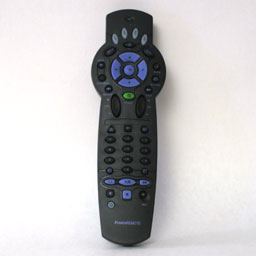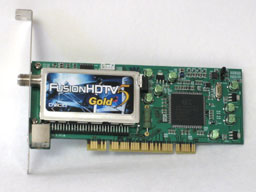HTPC - TV Tuner Reviews
by Jarred Walton on December 7, 2005 12:05 AM EST- Posted in
- Smartphones
- Mobile
DVICO Fusion5 Gold
The Fusion5 Gold is the top-end product from DVICO. Having never used any of their other cards, we can't really say how it compares to previous models. We started with the latest software version at the time of testing, FusionHDTV version 3.11. As Murphy would have expected, a new beta version 3.19.05 is now available, so we've retested the card. (Don't worry about the software being "beta" as opposed to an official release; version 3.11 and all the preceding versions are just as "beta" in our opinion.) Updated software has been made available on a pretty regular basis (every month or two), and we would venture to say that earlier versions of the software had quite a few bugs. (Forum posts around the web will quickly show this to be the case.) 3.11 definitely has some problems, but 3.19 seems to have finally addressed the majority of our concerns.
The card itself is notable for several reasons. First, it is a half-height card. Putting this into any PCI slot should present no problem, but DVICO actually went the extra mile and included a half-height mounting bracket if you want to use it in a slim form factor case. That's a great decision on their part, and it makes this the only card of the three that could be used in something like the Aopen MZ855-II or quite a few OEM PC systems. (The tuner on the card does get quite hot, though, so perhaps it wouldn't be a good idea to put it in such a small case.)
The smaller design does have some drawbacks, unfortunately. For one, the card only has a single antenna input, with an S-VIDEO port that can also be used with a Composite dongle. The card also depends on software to do a portion of the work, helped by a Connexant CX23882 chip as well as additional chips inside the LG "tuner box". The decoding of the digital channels is done in software, but FusionHDTV supports DxVA graphics cards, which can be used to offload a decent amount of the work with most recent ATI and NVIDIA chips.
Besides the card, there are a couple of other pieces of hardware. A remote is included, along with a USB receiver with which the remote communicates. While the remote is fully functional, we can't say that it's very elegant. This is the largest remote of any of the products, and it's also the ugliest remote. If that matters to you, look elsewhere, but we really can't say that it's a deal breaker. You'll also want to be careful not to press the wrong power button (the one in the lower left corner of the remote), as you can accidentally shut down/suspend the PC rather than just turning off the software interface.
There is a Fusion5 Lite card available, with the primary difference being support for additional encoding options with the Gold version and some additional software. You can see the comparison sheet at the bottom of the DVICO specifications page. The Lite model also omits the remote, which adds another $20-$40 if purchased separately. For the extra $30, it's probably worthwhile to simply go with the Gold card, unless you're sure that you don't want the extras. The remote isn't technically necessary, especially if you have a wireless mouse with a decent reception range.
The Fusion5 Gold is the top-end product from DVICO. Having never used any of their other cards, we can't really say how it compares to previous models. We started with the latest software version at the time of testing, FusionHDTV version 3.11. As Murphy would have expected, a new beta version 3.19.05 is now available, so we've retested the card. (Don't worry about the software being "beta" as opposed to an official release; version 3.11 and all the preceding versions are just as "beta" in our opinion.) Updated software has been made available on a pretty regular basis (every month or two), and we would venture to say that earlier versions of the software had quite a few bugs. (Forum posts around the web will quickly show this to be the case.) 3.11 definitely has some problems, but 3.19 seems to have finally addressed the majority of our concerns.
The card itself is notable for several reasons. First, it is a half-height card. Putting this into any PCI slot should present no problem, but DVICO actually went the extra mile and included a half-height mounting bracket if you want to use it in a slim form factor case. That's a great decision on their part, and it makes this the only card of the three that could be used in something like the Aopen MZ855-II or quite a few OEM PC systems. (The tuner on the card does get quite hot, though, so perhaps it wouldn't be a good idea to put it in such a small case.)
The smaller design does have some drawbacks, unfortunately. For one, the card only has a single antenna input, with an S-VIDEO port that can also be used with a Composite dongle. The card also depends on software to do a portion of the work, helped by a Connexant CX23882 chip as well as additional chips inside the LG "tuner box". The decoding of the digital channels is done in software, but FusionHDTV supports DxVA graphics cards, which can be used to offload a decent amount of the work with most recent ATI and NVIDIA chips.
 |
 |
| Click to enlarge. | |
Besides the card, there are a couple of other pieces of hardware. A remote is included, along with a USB receiver with which the remote communicates. While the remote is fully functional, we can't say that it's very elegant. This is the largest remote of any of the products, and it's also the ugliest remote. If that matters to you, look elsewhere, but we really can't say that it's a deal breaker. You'll also want to be careful not to press the wrong power button (the one in the lower left corner of the remote), as you can accidentally shut down/suspend the PC rather than just turning off the software interface.
There is a Fusion5 Lite card available, with the primary difference being support for additional encoding options with the Gold version and some additional software. You can see the comparison sheet at the bottom of the DVICO specifications page. The Lite model also omits the remote, which adds another $20-$40 if purchased separately. For the extra $30, it's probably worthwhile to simply go with the Gold card, unless you're sure that you don't want the extras. The remote isn't technically necessary, especially if you have a wireless mouse with a decent reception range.











77 Comments
View All Comments
JarredWalton - Wednesday, December 7, 2005 - link
Does DirectShow encoding plug into the VFW interface? (I think I've only used it for decoding, not encoding.) Same goes for AVI.NET - I haven't ever heard about that one, but then there's all sorts of stuff I've never heard of. :)xtknight - Thursday, December 8, 2005 - link
DirectShow doesn't necessarily use VfW. It's a separate interface for the most part, although you can still plug in VfW codecs in DirectShow filter graphs (basically flowcharts for video playback/capture/etc). You probably have only used it for decoding because there are not many DirectShow encoders.Homepage for AVI.NET: http://www.clonead.co.uk/">http://www.clonead.co.uk/
xtknight - Wednesday, December 7, 2005 - link
Realtime encoding can also be done by DirectShow, but I'm not aware of any apps that use it.sprockkets - Wednesday, December 7, 2005 - link
if it supports divx it supports xvid usually as well.Of course I could be wrong, but the way it works is they encode differently, but both can be decoded the same, right? Xvid can decode divx, so isn't like the same with mp3, different encoders but one decoder can do it all, since it is just mpeg-4?
segagenesis - Wednesday, December 7, 2005 - link
There is good reason for using Divx despite the fact xvid/ffdshow exist. Primarily from experience I should say taht xvid/ffdshow (with the latter of the two being particuarly bad) are slower than Divx as far as playback speed. This becomes more noticeable on slower computers, actually making a difference between full speed and jittery playback on some. If you have the CPU power, however, go for using xvid/ffdshow combination.bofkentucky - Wednesday, December 7, 2005 - link
Problem is, my cable boxes (Motorolla 6412, Dual tuner, DVR) can only output HD signals on the component, DVI, and HDMI ports, anyone know of a HDTV tuner card than has component or DVI in or a converter box that can take a component in coax out without mangling the signal?Griswold - Tuesday, December 13, 2005 - link
|-------| AFPL )
|-------
|
|
The Boston Dangler - Wednesday, December 7, 2005 - link
There is no such beast, nor will there be.gibhunter - Wednesday, December 7, 2005 - link
I too have the Moto 6412 Dual Tuner HD box. It is so good that it has kept me from actually building an HTPC. Now regarding your question, I don't think there is a way to do it. I do know from reading the www.avsforum.com that there is a driver for windows that will allow you to hook up a PC to the Moto DVR using the firewire connection. Then you can just copy the recordings straight from the DVR instead of re-recording them on the PC.Beenthere - Wednesday, December 7, 2005 - link
As in NO I have never considered using my PC as a home entertainment center. I guess some folks do but for me I'd prefer to build an "entertainment center" from commercial hardware components, not from add-ins to my PC.I could see a college student or someone with limited space combining their PC and movie viewing into one piece of hardware or maybe for viewing at work, but for the home, I don't see the advantage of using your PC for the basis of an entertainment center when it's not the best "tool for the job".